Mexico & Guadalupe
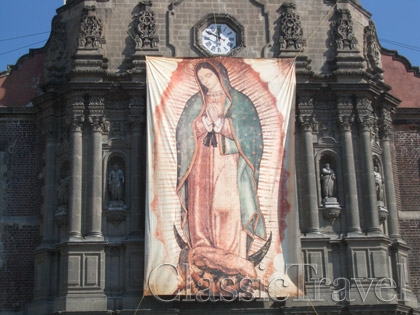
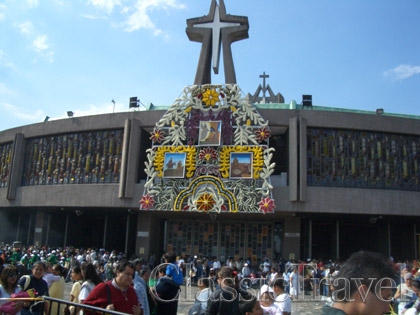
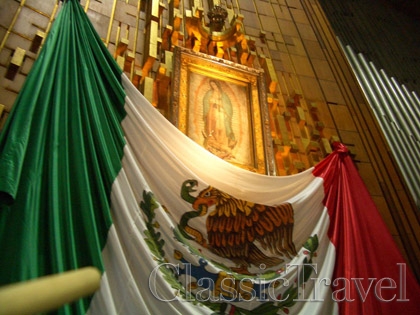
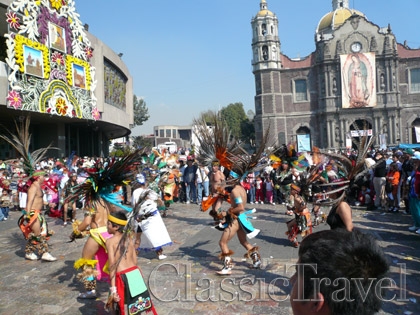
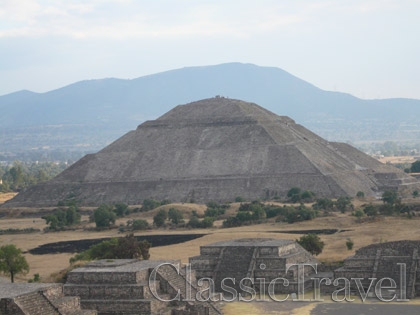
Mexico & Guadalupe
Pilgrimage to the Sanctuary of Guadalupe
Take part in annual celebrations commemorating Our Lady of Guadalupe. Also included: Mexico City, Cholula, Puebla.
-
Author: Emil & Camille (Trip Participant)Travel date: November 2016Date posted: 05 December 2016
Add Comments or Review the Trip
Day 1: Flight: Newark - Mexico City
Departure to Mexico City with United Airlines.
Airport pick up by our guide Gregory and transfer to hotel Casablanca in city center. On the way, a short tour of the capital. Welcome drink, dinner and overnight. (D)
Day 2: City tour Mexico City
After breakfast, drive to the famous Anthropological Museum, which will allow you to better understand the history of Mexico. Then we will visit the historical city center starting from the monuments located at the square called "Zocalo". We will visit the Church of Saint Catherine, the Cathedral, the National Palace with the famous frescoes of Diego Rivera and see the ruins of Templo Mayor, the most important Aztec temple, destroyed during the Spanish conquest. Dinner and overnight at the hotel. (B,D)
Day 3: Celebrations of Our Lady of Guadalupe - Teotihuacan
After breakfast, transfer to Basilica of Our Lady of Guadalupe for the main annual ceremonies celebrating the appearance of Our Lady of Guadalupe to St. Juan Diego. Participation in Holy Mass celebrated by the episcopate of Mexico as well as priests from around the world taking part in the ceremonies. Some time to observe the thousands of natives arriving and celebrating from all over the country to pay homage to Our Lady. In the afternoon, drive to the famous Teotihuacan ruins with huge pyramids of the Sun and the Moon as well as dozens of other buildings along the Avenue of the Dead. Farewell dinner buffet in a local restaurant by the pyramids. Return to our hotel in the city center. (B,D)
Day 4: Mexico City - Cholula - Puebla
Breakfast at hotel. Departure from the hotel heading towards Puebla. We will stop at Cholula, famous for 365 churches; we will see only a few of them - including the church situated on top of a huge pyramid from the times of Toltec and Aztecs. After arrival to Publa we'll check into our hotel. We will begin a tour of Puebla, known for the great religiousness of the inhabitants, founded in 1531 by monks from the Franciscan and Dominican orders, we will see the beautiful colonial center of the city with the cathedral and the church of Santo Domingo. Holy Mass. Dinner at a restaurant serving the famous "mole" - a chicken in chocolate with spicy spices. Overnight in a hotel in the city center. (B,D)
Day 5: Puebla - Tenango del Aire - return to Mexico City
After breakfast, drive to Chalco, situated in a wide valley, where John Paul II, in 1990, celebrated Mass for over 500,000 faithful. A visit to the Cathedral dedicated to Saint James the Apostle. Transfer to Tenango del Aire, where there is the Sanctuary of Divine Mercy, which is looked after by the Polish Pallottine Fathers. Meeting with the parish priest and brothers, who will discuss their often difficult pastoral work. Mass in the church of St. John the Baptist. Arrival in the city of Mexico for dinner and overnight. (B,D)
Day 6: Flight: Mexico City - Newark
Breakfast at hotel in Mexico City. Transfer to airport and non-stop flight to Newark. (B)
***End of the program***
Abbreviations: B - Breakfast, L - Lunch, D – Dinner
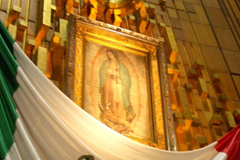 Our Lady of Guadalupe
Our Lady of Guadalupe
Also known as the Virgin of Guadalupe, Our Lady of Guadalupe is a celebrated Catholic icon of the Virgin Mary.
According to tradition, Juan Diego, a simple indigenous peasant, saw a vision of a young woman on December 9, 1531, while he was on the hill of Tepeyac near Mexico City, Mexico. He told the local bishop, who asked for some proof. Three days later, according to legend, the image of Mary appeared miraculously on his cloak when he was showing it to the bishop. Today the icon is displayed in the Basilica of Guadalupe nearby, one of the most visited Catholic shrines in the world. The Virgin of Guadalupe is Mexico's most popular religious and cultural image, with the titles "Queen of Mexico", "Empress of the Americas", and "Patroness of the Americas"; both Miguel Hidalgo (in the Mexican War of Independence) and Emiliano Zapata (during the Mexican Revolution) carried flags bearing the Our Lady of Guadalupe, and Guadalupe Victoria, the first Mexican president changed his name in honor of the icon.
Mexico City (Ciudad de México)
Mexico City is the Federal District (Distrito Federal), capital of the Mexico and seat of the federal powers of the Mexican Union. It is also the largest city in Mexico as well as the largest city in the Americas and the world's third largest metropolitan area by population, after Seoul and Tokyo. It is a federal entity within Mexico which is not part of any one of the 31 Mexican states but belongs to the federation as a whole. Mexico City is the most important political, cultural, and financial center in the country.
The city was originally built on an island of Lake Texcoco by the Aztecs in 1325 as Tenochtitlan, which was almost completely destroyed in the 1521 siege of Tenochtitlan , and subsequently redesigned and rebuilt in accordance with the Spanish urban standards. In 1524, the municipality of Mexico City was established, known as México Tenochtitlán, and as of 1585 it was officially known as La Ciudad de México (Mexico City). Mexico City served as the political, administrative and financial centre of a major part of the Spanish colonial empire. After independence from Spain was achieved, the Federal District was created in 1824.
Teotihuacan
Teotihuacan is an enormous archaeological site in the Basin of Mexico, containing some of the largest pyramidal structures built in the pre-Columbian Americas. Apart from the pyramidal structures, Teotihuacan is also known for its large residential complexes, the Avenue of the Dead, and numerous colorful, well-preserved murals. Additionally, Teotihuacan produced a thin orange pottery style that spread through Mesoamerica.
The city was thought to have been established around 200 BCE and continued to be built until about 250 CE. The city lasted until sometime between the 7th and 8th centuries CE. At its zenith in the first half of the 1st millennium AD, Teotihuacan was the largest city in the pre-Columbian Americas. At this time it may have had more than 200,000 inhabitants, placing it among the largest cities of the world in this period. Teotihuacan was even home to multi-floor apartment compounds built to accommodate this large population.



